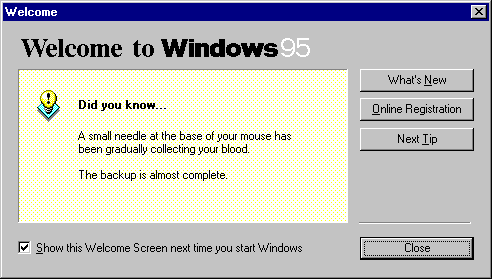
Some very H. P. Lovecraft style redesigns of some classic Win95 UI.
A Slower Speed of Light Official Trailer — MIT Game Lab (by Steven Schirra)
“A Slower Speed of Light is a first-person game in which players navigate a 3D space while picking up orbs that reduce the speed of light in increments. A custom-built, open-source relativistic
graphics engine allows the speed of light in the game to approach the player’s own maximum walking speed. Visual effects of special relativity gradually become apparent to the player, increasing
the challenge of gameplay. These effects, rendered in realtime to vertex accuracy, include the Doppler effect; the searchlight effect; time dilation; Lorentz transformation; and the runtime
effect.
A production of the MIT Game Lab.
Play now for Mac and PC! http://gamelab.mit.edu/games/a-slower-speed-of-light/”

“Jon Hamm And Adam Scott’s ‘greatest Event In Tv
History’ Was A Tribute To A Forgotten ’80s Classic
If you know more about Simon and Simon than its intro and general premise, you’re better at TV than I am. If you’ve never heard of Simon and Simon, you’re the BEST at TV because, honestly, Simon
& Simon — a CBS series about two mismatched brothers who ran a private detective service; it ran for eight seasons — wasn’t good.
Source: Uproxx”
“The disc itself is about 5 inches in diameter. It can record one hour of stereo music on one side — and it is only a one-sided disc, it’s not meant to be played on two sides…”
Sony demos the CD at TED in 1984 (by TEDBlogVideo)
TypeScript is a typed superset of JavaScript that adds interfaces, and type safety and compiles to JavaScript. In VS this means you get much better auto completion suggestions. Watch the Channel9 video.
According to the links within this article, although the root URI of the router requires authentication, the /password.cgi URI doesn’t and the resulting returned HTML contains (but does not display) the plaintext of the password, as well as an HTML FORM to modify the password that is exploitable by CSRF.
The attack… infected more than 4.5 million DSL modems… The CSRF (cross-site request forgery) vulnerability allowed attackers to use a simple script to steal passwords required to remotely log in to and control the devices. The attackers then configured the modems to use malicious domain name system servers that caused users trying to visit popular websites to instead connect to booby-trapped imposter sites.
drug companies hiding the results of clinical trials.
(via I did a new talk at TED, on drug companies and hidden data.)
Eric gets the most entertaining mail.
You have failed to comply with them after all the warning and instructions given to you, but since you are also among the terrorist we are facing in the country, I will personal make sure that I wipe away the crime in the state and I promise you that you will definitely pay with your life because I am here to protect the interest of my people and not to put them in shame, you suppose to support this government and not to spoil it.
Nathan Barnatt makes awesome videos. This is a playlist of my favorites of his. (via http://www.youtube.com/playlist?list=PLIjrVnNvXzb8N5tjV3fowJqYwuDM__WVf)
Megabox is an ad-replacer - replacing ads on the web as you browse with its own. Ignoring security concerns, I hope this doesn’t result in over prescriptive laws that endanger things like Greasemonkey.
To listen to songs through Megabox, users will have two options—purchasing the music through the service, or installing “Megakey” software onto their computer to listen for free. The Megakey software, as Dotcom explained to Torrentfreak, acts like ad-blocking software—except that it isn’t. Megakey allows most advertisements to appear, but replaces about 15 percent of the ads served up by websites with ads hosted by Megabox.
Mitt Romney quotes on screen shots of Lucille from Arrested Development works surprisingly well.
Welcome news. Glad to hear they’re looking for improvements.
… the USPTO has also worked with Stack Exchange, … to create a new site called Ask Patents. … Examiners or others looking for prior art can post questions about a specific application, and members of the general public can respond with evidence that an applicant was not the first to invent the subject matter of the application.

How the 8.5” x 11” Piece of Paper Got Its Size
Why do we use a paper size that is so unfriendly for the basic task of reading? According to a very interesting post by Paul Stanley, the rough dimensions of office paper evolved to accommodate handwriting and typewriters with monospaced fonts, both of which rendered many fewer characters per line. “Typewriters,” he explains, “produced 10 or 12 characters per inch: so on (say) 8.5 inch wide paper, with 1 inch margins, you had 6.5 inches of type, giving … around 65 to 78 characters.” This, he says, is “pretty close to ideal.”
Read more. [Image: Picsfive/Shutterstock]
An analysis of leaked PIN numbers.
… nearly 11% of the 3.4 million passwords are 1234 !!!
A howto on making your video game accessible to those with disabilities (blind, color blind, deaf, etc)
The AbleGamers Foundation has created a 48-page document it hopes will serve as a how-to guide for game developers and publishers on how to create more accessible games. The in-depth guide by the disability non-profit covers in great detail how to make games available to those with varying degrees of mobility, hearing, visual and cognitive issues.
Level 7 of the Stripe CTF involved running a length extension attack on the level 7 server's custom crypto code.
@app.route('/logs/')
@require_authentication
def logs(id):
rows = get_logs(id)
return render_template('logs.html', logs=rows)
...
def verify_signature(user_id, sig, raw_params):
# get secret token for user_id
try:
row = g.db.select_one('users', {'id': user_id})
except db.NotFound:
raise BadSignature('no such user_id')
secret = str(row['secret'])
h = hashlib.sha1()
h.update(secret + raw_params)
print 'computed signature', h.hexdigest(), 'for body', repr(raw_params)
if h.hexdigest() != sig:
raise BadSignature('signature does not match')
return TrueThe level 7 web app is a web API in which clients submit signed RESTful requests and some actions are restricted to particular clients. The goal is to view the response to one of the restricted actions. The first issue is that there is a logs path to display the previous requests for a user and although the logs path requires the client to be authenticatd, it doesn't restrict the logs you view to be for the user for which you are authenticated. So you can manually change the number in the '/logs/[#]' to '/logs/1' to view the logs for the user ID 1 who can make restricted requests. The level 7 web app can be exploited with replay attacks but you won't find in the logs any of the restricted requests we need to run for our goal. And we can't just modify the requests because they are signed.
However they are signed using their own custom signing code which can be exploited by a length extension attack. All Merkle–Damgård hash algorithms (which includes MD5, and SHA) have the property that if you hash data of the form (secret + data) where data is known and the length but not content of secret is known you can construct the hash for a new message (secret + data + padding + newdata) where newdata is whatever you like and padding is determined using newdata, data, and the length of secret. You can find a sha-padding.py script on VNSecurity blog that will tell you the new hash and padding per the above. With that I produced my new restricted request based on another user's previous request. The original request was the following.
count=10&lat=37.351&user_id=1&long=%2D119.827&waffle=eggo|sig:8dbd9dfa60ef3964b1ee0785a68760af8658048ccount=10&lat=37.351&user_id=1&long=%2D119.827&waffle=eggo%80%02%28&waffle=liege|sig:8dbd9dfa60ef3964b1ee0785a68760af8658048cCode review red flags included custom crypto looking code. However I am not a crypto expert and it was difficult for me to find the solution to this level.
Level 5 of the Stripe CTF revolved around a design issue in an OpenID like protocol.
def authenticated?(body)
body =~ /[^\w]AUTHENTICATED[^\w]*$/
end
...
if authenticated?(body)
session[:auth_user] = username
session[:auth_host] = host
return "Remote server responded with: #{body}." \
" Authenticated as #{username}@#{host}!"This level is an implementation of a federated identity protocol. You give it an endpoint URI and a username and password, it posts the username and password to the endpoint URI, and if the response is 'AUTHENTICATED' then access is allowed. It is easy to be authenticated on a server you control, but this level requires you to authenticate from the server running the level. This level only talks to stripe CTF servers so the first step is to upload a document to the level 2 server containing the text 'AUTHENTICATED' and we can now authenticate on a level 2 server. Notice that the level 5 server will dump out the content of the endpoint URI and that the regexp it uses to detect the text 'AUTHENTICATED' can match on that dump. Accordingly I uploaded an authenticated file to
https://level02-2.stripe-ctf.com/user-ajvivlehdt/uploads/authenticatedhttps://level05-1.stripe-ctf.com/user-qtoyekwrod/?pingback=https%3A%2F%2Flevel02-2.stripe-ctf.com%2Fuser-ajvivlehdt%2Fuploads%2Fauthenticated&username=a&password=aI didn't see any particular code review red flags, really the issue here is that the regular expression testing for 'AUTHENTICATED' is too permisive and the protocol itself doesn't do enough. The protocol requires only a set piece of common literal text to be returned which makes it easy for a server to accidentally fall into authenticating. Having the endpoint URI have to return variable text based on the input would make it much harder for a server to accidentally authenticate.